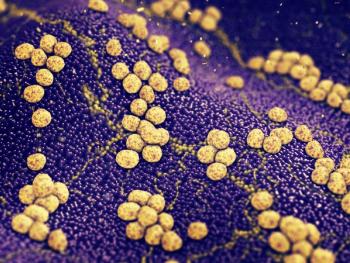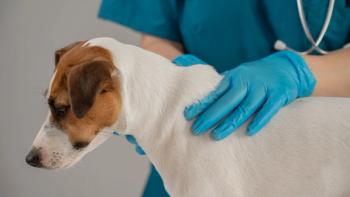
Optimizing topical therapy (Proceedings)
Topical therapy is an important symptomatic and complimentary treatment option in the management of various skin diseases. Canine skin is often more sensitive than is human skin due to anatomical and physiological differences, including differences in the thickness of the stratum corneum, skin pH and hair follicle density which can facilitate cutaneous penetration of active ingredients.
Topical therapy is an important symptomatic and complimentary treatment option in the management of various skin diseases. Canine skin is often more sensitive than is human skin due to anatomical and physiological differences, including differences in the thickness of the stratum corneum, skin pH and hair follicle density which can facilitate cutaneous penetration of active ingredients. The active ingredients penetrate the skin through the intercellular spaces (lipophilic molecules), through the epidermal cells (ion compounds). Several formulations such as ointments, creams, lotions shampoos, spot-on, etc. are available and may include many active ingredients. For successful topical management the selection of the appropriate formulation and active ingredient is important. However, the selection may depend on concurrent therapy, the animal's temperament owner compliance, and the concentration and potential side effects of the active ingredients. Client communication is important and should underline the great value of medicated shampoos for the treatment of skin diseases.
Ointments, creams and gels
Creams and ointments are a mixture (emulsion) of oil and water. They are usually used on dry skin, and not on oozing (exudative) areas. Gels are composed of a thixotropic (gel at rest, but fluid when agitated) base (usually containing propylene glycol), pass through the hair coat to the skin and are less messy and occlusive than creams and ointments. These bases are used as vehicles for many agents:
Topical glucocorticoids
Have anti-inflammatory and antipruritic properties as well as antiproliferative and immunosuppressive effects. These formulations are useful for localized lesions (e.g., cheilitis, blepharitis, pododermatitis, nasal lesions, pyotraumatic dermatitis, lick granuloma). Common glucocorticoids found are: dexamethasone, betamethasone and hydrocortisone.
Localized skin atrophy and comedo formations can be seen with excessive long-term application.
Immunomodulators
Tacrolimus (Protopic 0.1%; Astella), a calcineurin inhibitor has been shown to be effective in the treatment of localized lesions of vasculitis, auto-immune diseases (e.g. discoid lupus, pemphigus erythematosus), and canine atopic dermatitis.
Antibiotics
Formulations containing fusidic acid and mupirocin (Bactoderm; Pfizer) are useful for treating localized lesions of pyoderma.
Antifungals
Human products containing azole derivatives, nystatin or amphotericin B can be used on localized lesions of dermatophytosis, Malassezia dermatitis or candidiasis.
Lotions, rinses and sprays
Lotions are liquids in which active agents are dissolved or suspended. Rinses are concentrated and must be diluted before use. Pump-sprays containing lotions are commonly used in canine dermatology (after or in between shampoos). They contain different agents:
Antibacterials
Chlorhexidine is used in lotions, as an antibacterial agent.
Antifungals
Lime sulfur rinse is effective against both dermatophytosis and ketoconazole against Malassezia.
Glucocorticoids
Spray: triamcinolone (Genesis, Virbac); hydrocortisone (ResiCort, Virbac)
Nonsteroidal antipruritic formulations
e.g., containing pramoxine, lidocain (Dermacool, Virbac), colloidal oatmeal
Moisturizers
Dry skin is a common condition in dogs and can be controlled moisturizers. They lubricate, rehydrate and soften the skin. Diluted in water, they can be massaged into the skin or applied as a lotion/rinse. Usually they are applied after a bath on the towel dried skin and between baths as needed. For example: lactic acid, glycerin, propylene glycol, urea and chitosanide.
Shampoos
Traditional shampoo formulations are composed of surfactants (cleansing agents, foaming agents and conditioners) as well as thickeners, softeners, sequestering agents, preservatives, and fragrances. Surfactants are amphiphilic molecules, i.e., molecules with a dual affinity, both for water and oil. In water, surfactants form micelle structures allowing surfactant to emulsify, render soluble and disperse oils, dirt and debris.
How to use veterinary shampoos
Ideally, a shampoo possessing both cleansing and therapeutic properties should be applied twice at each use. The mechanical effect (elimination of scales and crusts) is beneficial in all cases. Water rehydrates the stratum corneum although this effect is temporary in the absence of moisturizers. At the second application, the shampoo must be left on for 10 to 15 minutes, to allow proper contact time. The skin should then be rinsed thoroughly and towel dried. The shampoo may be applied several times a week for 2 weeks. The frequency is then reduced to every 1-2 weeks as needed.
Efficacy of shampoos
Prolonging the action of active ingredients has been made possible with Spherulites® technology to increase bioavailability of therapeutic agents and promote immediate and residual moisturizing properties (reinforced by chitosanide).
Shampoo therapy in canine pyoderma
Antibacterial shampoos reduce the cutaneous bacterial population and also remove tissue debris and exudate, allowing direct contact of the active ingredient with the organism. Mild cases of superficial pyoderma can be treated with shampoos alone. In dogs that are prone to recurrent folliculitis antibacterial shampoos may have a prophylactic effect if used regularly. Chlorhexidine (0.5 to 4%, diacetate or digluconate) is very effective against most bacteria (gram + and -). It has a prophylactic effect as some remains on the skin despite rinsing and is well tolerated. Povidone-iodine very effective antimicrobial but tends to dry out skin and is inactivated by organic material.
Benzoyl peroxide (2 to 3%) has a strong antibacterial activity, an excellent prophylactic effect but irritation can occur at higher concentrations (erythema, pruritus and pain). Ethyl lactate is used at a concentration of 10%, which rarely causes undesirable side effects (irritation, erythema, pruritus). When used twice weekly it can reduce the length of the course of systemic antibiotics required in canine superficial pyoderma. Piroctone olamine is an antifungal agent (see below) which also has antibacterial properties.
Shampoo therapy in fungal diseases
Antimycotic shampoos (ketoconazole, miconazole, 1:1 combination of ketoconazole and chlorhexidine (e.g. KetoChlor, Virbac)) are mainly used in the treatment of Malassezia dermatitis. Although they have some benefit in reducing the numbers of dermatophytic spores, they are not effective as a sole therapy in the treatment of dermatophytosis.
Shampoo therapy in allergic diseases
All shampoos are likely to remove allergens from the skin, which is believed to be helpful in canine atopic dermatitis. They also help to rehydrate dry skin. Shampoos with an antipruritic effect (1% hydrocortisone, 0.01% fluocinolone, 2% diphenhydramine, colloidal oatmeal) can be good adjunctive treatments. A shampoo specifically designed for canine atopic dermatitis contains linoleic acid and gamma linolenic acid, mono and oligosaccharides, vitamin E, and piroctone olamine.
Shampoo therapy in keratoseborrheic disorders
Keratomodulating agents work in two different ways:
- keratoplastic (keratoregulating): Restoration of normal keratinocyte multiplication and keratinization. Some of them probably exert a cytostatic effect on basal cells, thereby reducing their rate of division. For example: Coal tar.
- keratolytic: Elimination of excess corneal layers, by increasing desquamation (ballooning of corneocytes rendering the stratum corneum softer and a reduction of intercellular cohesion that increases their shedding). For example: Salicylic acid.
Agents with both properties are Sulfur, Selenium disulfide and Ammonium lactate.
- - antiseborrheic: Inhibition or reduction sebum production by the sebaceous glands. For example: Sulfur, Selenium disulfide, Benzoyl peroxide (also antibacterial and follicular flushing action), Zinc gluconate, Vitamin B6 (pyridoxine), and Phytosphingosine.
Essential fatty acids and moisturizers
Various veterinary shampoos have incorporated essential fatty acids for their softening and moisturizing properties. Some shampoos contain moisturizers such as glycerin and lactic acid.
Newsletter
From exam room tips to practice management insights, get trusted veterinary news delivered straight to your inbox—subscribe to dvm360.




